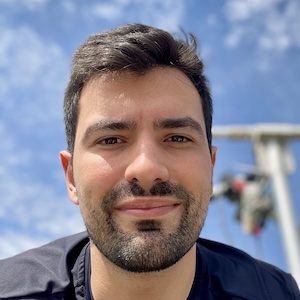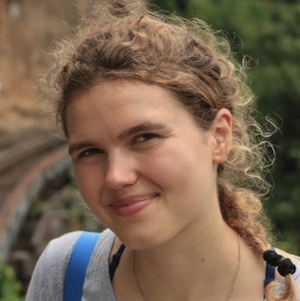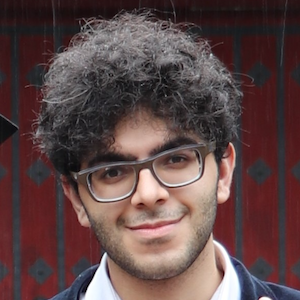2022 Cohort
|
Owen Allemang
PhD project title: Arctic Processes Under Ice: Structures in a Changing Climate Supervisors: Dr Emma Boland (British Antarctic Survey), Alexander Brearley (British Antarctic Survey), Ali Mashayek (Dept of Earth Sciences ), John Taylor (Dept of Applied Maths and Theoretical Physics) PhD project description: My PhD project is centred on harnessing machine learning (ML) to decipher and forecast shifts in the Arctic environment, drawing on almost two decades of ocean observation data from sources such as Ice Tethered Profilers (ITP), ship-based U-DASH, and ARGO profiles. A significant aspect of the research recognises the absence of a standardised Arctic Ocean water mass classification system and aims to establish one. By applying ML techniques, like Gaussian Mixture Models and hierarchical clustering to available data, which includes temperature and salinity profiles, the research seeks to offer an objective classification framework for Arctic water masses. This enhanced comprehension will further our understanding of their role in the evolving Arctic climate. The Arctic is characterised by unique processes, notably the double-diffusive staircases and the emerging Arctic eddy fields, which play a pivotal role in influencing ocean mixing and heat transfers. With high-resolution observations from the Canadian Basin, the research hypothesises that ML can more swiftly and objectively pinpoint these processes compared to traditional methods. By focusing on the Canadian Basin data, insights will be drawn on double-diffusive staircases and Arctic eddies, refining our grasp of Arctic ocean mixing, heat fluxes, and the larger Arctic climate evolution. Furthermore, current General Circulation Models (GCMs) often provide an inadequate representation of the Arctic Ocean, thus compromising their ability to accurately predict future changes. In response, the CANARI project is developing tailored models for the Arctic. By juxtaposing these with the existing GCMs using ML, the research aims to identify gaps and enhancements in how Arctic Ocean dynamics are represented. By combining ensemble learning with data from the imminent CANARI models, the project will delve into the effects of model intricacies on Arctic water mass depictions. Ultimately, the research aspires to reconcile the observed and modelled dynamics of the Arctic Ocean, improving the precision of Arctic environment portrayals in GCMs and augmenting our understanding of the Arctic's susceptibility to climate change. Prior to joining the CDT, I spent a year in Cranfield completing a MSc in Environmental Engineering and the year before I graduated from Cranfield with a MSc in Applied Artificial Intelligence. My master’s thesis was on improving global gridded precipitation using NWP models and CNN. The MSc in AI was part of double degree programme with IPSA, a French aeronautics and space engineering MSc where I majored in embedded systems, space launchers and satellites. In my spare time, I like to read and play music. I recently started play ice hockey. |
|
Felipe Begliomini - 4C student
PhD project title: Spatial Insights on Restoration Strategies for Atlantic Forest Conservation Supervisors: Professor David Coomes (Dept of Plant Sciences) and Professor Srinivasan Keshav (Dept of Computer Science and Technology) PhD project description: The Brazilian Atlantic Forest, renowned for its immense biodiversity value, was heavily exploited over three hundred years, but is now nationally and internationally recognised as region of large ecosystem restoration. This unique and ecologically rich biome plays a pivotal role in sustaining ecosystems and supporting human livelihoods. My PhD project takes a comprehensive approach to evidence-based preservation and restoration, shedding light on the intricacies of the Atlantic Forest ecosystem. The objectives of my project will be to firstly produce a comprehensive literature meta-analysis to provide valuable insights into the driving forces and policies affecting deforestation, reforestation, and natural regrowth. This review will provide an integrated framework to analyse forest dynamics at a regional scale. Secondly, by leveraging remote sensing data, I will assess the viability and longevity of reforestation initiatives within the Atlantic Forest. This assessment will also identify the optimal spatial resolution for effectively monitoring the fragmented biome, connecting these findings with the factors influencing reforestation success. Lastly, I will collect and integrate a diverse range of environmental and socio-economic data layers, culminating in the creation of a comprehensive suitability map for forest restoration which explicitly optimises conservation benefits and revenue generation at both farm and landscape scales. This research will deepen understanding of Atlantic Forest dynamics, provide insights into the effectiveness of reforestation projects, and determine the optimal spatial resolution for effective monitoring. Moreover, it is poised to contribute to more informed and sustainable practices for safeguarding the Atlantic Forest, with broader implications for tropical landscape conservation Prior to joining AI4ER CDT, I completed two undergraduate degrees, one in Marine Sciences (2016) and the other in Environmental Engineering (2019), both at the Federal University of São Paulo (Brazil). In my first undergraduate degree, my research interests were related to the effects of a multi-impacted coastal area on mollusc shells (https://doi.org/10.1016/j.envpol.2017.04.045). In my second degree, I developed a study concerning the role of São Paulo’s protected areas in preserving the Guarani Aquifer’s recharge zones. In 2020, I started my Master’s degree in Remote Sensing at the Brazilian National Institute for Space Research (INPE). I worked on estimating water quality parameters from orbital and field remote sensing data. My dissertation aimed to retrieve Phycocyanin (a photosynthetic pigment with a major presence in Cyanobacteria) concentrations using hyperspectral orbital remote sensing data and machine learning algorithms. My study was part of the MAPAQUALI project, which aims to create an online platform for monitoring the water quality of Brazilians' inland and coastal waters. I was also involved in other studies, such as estimating the Secchi Disk Dept for Brazilian waters from Sentinel-2/MSI images (https://doi.org/10.1016/j.isprsjprs.2021.10.009), deriving a method for correcting the adjacency effect in orbital images for inland waters (https://doi.org/10.3390/rs14081829), and mapping the phytoplankton biodiversity in the Amazon floodplain. Spending time in natural landscapes, watching volleyball games, and practicing sports are my favourite activities besides studying the environment. |
|
Lisanne Blok
PhD project title: Extreme sea level and coastal flooding Supervisors: Prof Ali Mashayek (Dept of Earth Sciences) and Dr Andrea Marinoni (UiT, the Arctic University of Norway) PhD project description: In my PhD research, I am addressing the issue that sea level poses to local communities, particularly in the context of climate change. One of the key aspects of this is extreme sea level, an extreme event metric that is influenced by mean sea level, waves, storm surges and tides. It is projected that the frequency and magnitude of extreme events will significantly increase, thus, a framework that accurately estimates this risk is required for accurate climate adaptation policy. However, predicting extreme sea level and the associated risks is a complex task, mainly due to the inherent uncertainty in climate projections. It is important to understand source of the uncertainties, how the uncertainty of the different factors interact over time and whether the uncertainty is tied to a local region. I will be employing advanced probabilistic machine learning techniques, i.e. Bayesian Neural Networks, where each extreme sea level contributor will be featured as a probability density function. I am hoping to analyse the spatial and temporal interaction of these factors to enhance our understanding of the uncertainties regarding extreme sea level. With this knowledge, I am hoping to inform policymakers and the insurance industry where more monitoring and a change of climate adaptation plans will be required. Prior to joining the CDT, I completed my BSc degree in Geophysics from Imperial College London. At Imperial's Grantham Institute, I researched the application of country-specific Social Cost of Carbon in quantifying the effects of climate change and as well as statistical analysis on temperature climate risk in Bangladesh. I am specifically interested in the intersection of policy and environmental science and predicting climate risk in vulnerable regions. As an active member of the European Youth Parliament, I have chaired and presided sessions, focussing amongst other things on the Nord Stream 2 pipeline and sustainable shipping. |
|
Joshua Dimasaka
PhD project title: Global Disaster Risk Audit Supervisors: Professor Emily So (Director, Cambridge University Centre for Risk in the Built Environment and Department of Architecture) and Professor Christian Geiß (Head, Georisks & Civil Security, German Aerospace Center (DLR) and Professor, Institute of Geography, University of Bonn) Phd project description: When the Hyogo Framework for Action 2005-2015 concluded, a global concern on the increasing frequency and intensity of disasters, the exacerbating effects of climate change, and the higher rate of increase of human settlements exposed to disasters despite a decrease in their vulnerability urged the international community to jointly develop the Sendai Framework for Disaster Risk Reduction (SFDRR) 2015-2030. However, its 2023 midterm assessment has revealed inadequacies with prevailing short-termism, thus stressing the need for a reliable understanding of the evolving risk landscape. This short-termism of SFDRR has already been argued in the past because of the use of improper ‘snapshot’ metrics, which does not fully represent the incremental progress of countries by disregarding the scientific understanding of the occurrence of extreme events, as widely used in the state-of-the-art (SOTA) probabilistic catastrophe models. Despite the availability of SOTA models, modelling and ethical challenges remain in standardising exposure datasets across countries with different and lacking vulnerability characteristics. Early efforts in developing large-scale exposure datasets were able to map the distribution of human settlements and their vulnerabilities, which has been the basis of several global assessment reports. However, these datasets contain inherent biases that favour developed countries (e.g., least-developed countries have different and non-standard vulnerability characteristics because of the ubiquity of more informal settlements and different construction methodologies) and are increasingly outdated because of rapid urbanisation. Recently, several AI methods have shown promising results in addressing some of these problems using Earth observation datasets that can be combined with locally prepared datasets, offering a novel approach to audit disaster risk at large scales considering multiple periods of assessment including the SFDRR implementation. To this end, my project will investigate SOTA models and AI methods to quantify exposure and risk of the built environment at large scales, and will enable the beginnings of a global risk audit, measuring the changes of disaster risk profiles over time to assess whether countries are making progress. Specifically, I will explore some of the following key guiding themes and questions: How has the risk landscape at a building, neighbour, city, and country scale changed because of resilience programmes since the advent of the SFDRR? Has the number of buildings increased even while their contribution to the overall risk has reduced because they are less vulnerable than the buildings they replaced? For updates and collaborations, please visit my project website Prior to joining the CDT, I graduated with a Masters of Science in Civil and Environmental Engineering and a Master of Arts in Public Policy from Stanford University as a Knight-Hennessy scholar, and BSc in Civil Engineering (magna cum laude) from the University of the Philippines Los Baños. Through engineering, policymaking, and AI, I aspire to shape an equitable disaster-resilient future to face the global crisis caused by the pressing need to adapt to intensifying effects of climate change and other natural hazards. I previously worked for Stanford LBRE and the local government of Quezon City (Philippines) to support data-driven policies to manage their regional earthquake risks. At Stanford, I worked with US Geological Survey to use machine learning on NASA satellite imagery products to improve PAGER, a global real-time earthquake hazard and loss estimation system. I have also spent time at Arup, Stanford Urban Resilience Initiative, and FM Global Engineering & Research. I enjoy spending time with my dogs, hiking, and playing ukulele.
|
|
Onkar Gulati - 4C student
PhD project title: Furthering Decarbonisation Incentives Through Foundation Models for Tropical Forests Supervisors: Prof Anil Madhavapeddy (Dept of Computer Science and Technology), Professor Andrew Balmford (Dept of Zoology) PhD project description: Foundation models are neural networks trained via self-supervised learning on vast quantities of unlabelled data, typically based on the transformer architecture. These models have demonstrated substantially improved performance in natural-language processing and image generation, among other fields. ClimaX, the first foundation model for weather and climate science, was unveiled earlier this year and generated smaller root-mean-squared errors in downstream tasks including weather forecasting and climate downscaling as compared to the Integrated Forecast System and convolutional neural networks such as U-Net. The goal of this project is to better understand the capability of self-supervised learning to infer parameters of natural systems without foregoing socioeconomic impacts. In particular, we hypothesise that an enhanced understanding of tropical forests could be obtained through development of a dedicated foundation model utilising multimodal data. Such a model would have notable implications for how outcomes of carbon interventions are assessed globally, with potential downstream tasks including forecasts of forest cover, baselines of global biodiversity, and estimates of foregone economic output for project areas. Prior to joining the CDT, I completed my undergraduate studies at the University of Tokyo, where my senior thesis focused on developing a novel system for investigating the quantum mechanical phenomena dictating environmental magnetoreception in avian species. Afterwards, I spent the better part of a year working in private equity in Tokyo, with a particular focus on secondary funds and impact investments. I hope to tackle complex issues at the CDT from both a statistical and economic viewpoint. In my spare time, you'll find me exploring new varieties of coffee, hosting horror movie nights, or tutoring just about anything. |
|
Jovana Knezevic -4C student
PhD project title: Estimating Fire Susceptibility in tropical forests using Bayesian Networks Supervisors: Professor David Coomes (Dept of Plant Sciences) and Professor Srinivasan Keshav (Dept of Computer Science and Technology) PhD project description: The South American tropics are host to a number of nature-based solutions (NBS) and forest regeneration initiatives. However, the extent of degradation resulting from disturbances in this region has been on the rise. In 2022, the state of Amazonas recorded the highest wildfire emissions in 20 years. Although the total burned area has decreased globally, it has increased in the humid tropical forests. Wildfires can result in significant tree mortality and reduce the forest's ability to sequester carbon. Despite the significance of these forests and the escalating frequency of wildfires, there have been only a handful of machine learning studies of wildfires in this region. In fact, out of 300 papers reviewed in 2019 on machine learning in wildfire, only five papers focused on South American forests. NBS play a critical role in climate change mitigation through natural carbon sequestration, but face implementation challenges due to impermanence of forest carbon. Wildfire is a leading permanence risk for forest-stored carbon. To correctly price NBS offsets, there is a need for improved understanding and probabilistic estimation of carbon release schedule. Existing carbon projects frequently underestimate fire risk and do not employ realistic risk quantification in their permanence calculations. As an example, California's cap-and-trade program severely underestimated the fire risk, depleting 95% of its insurance buffer pool in the first ten years of a 100-year-long program. Assessment of future fire risk is essential for long-term carbon accounting in forests. The goal of my PhD project is to conduct a probabilistic risk assessment for wildfires in the South American tropics, using Bayesian networks and the available climate, vegetation and population remote sensing data. The proposed framework will be used to forecast future fire susceptibility by estimating fire occurrence and burn probabilities at different regional scales, given future climate predictions. The framework will allow for inclusion of both remote sensing data and domain expertise, and update probabilities as new data becomes available. Prior to joining the CDT, I moved from Serbia to the US to study at MIT, where I completed my undergraduate and master's degrees in Electrical Engineering and Computer Science. Before starting my PhD I spent nine years in the tech industry. I worked on a wide variety of software systems, from low-latency trading platforms for banking to mobile-cloud distributed systems for the automotive sector at companies across the size spectrum. My most recent position was as a tech lead for Google's Android Automotive personalization team. I left industry driven by curiosity and looking to apply my experience and skill to some of society's most pressing and challenging problems - understanding our environment and our sustainable place in it. In no small part, I'm motivated by my passion for backpacking, wildlife, and landscape photography. I would prefer that we still have those in 50 years.
|
|
Andrew McDonald
PhD project title: Advancing Spatiotemporal Generative Deep Learning and its Application to Sea Ice Forecasting Supervisors: Professor Rich Turner (Dept of Engineering), Dr Scott Hosking (British Antarctic Survey) PhD project description: The Arctic is warming at a rate four times the global average and has experienced a dramatic decline in sea ice. This decline is the direct result of anthropogenic greenhouse gas emissions. Even with drastic cuts to emissions, the occurrence of an ice-free summer in the Arctic Ocean is all but guaranteed in the next decade. Meanwhile, Antarctic sea ice has exhibited highly-variable behaviour over the course of the satellite record, growing on average from 1979 to 2010 before setting new record low extents in 2016, 2017, 2022, and 2023. The relative contributions of natural variability and anthropogenic influence in setting these minima are a subject of ongoing research, though the sheer scale and consistency of anomalously low Antarctic sea ice throughout 2023 in particular has raised red flags of anthropogenic influence and raised concerns of future Antarctic sea ice decline in a warming world. The impending loss of sea ice brings numerous scientific, social, political, and economic implications. Sea ice plays a critical role in regulating the Earth’s energy balance through the sea ice-albedo feedback mechanism; in mediating oceanic-atmospheric heat fluxes in driving midlatitude weather patterns; in supporting marine wildlife, terrestrial wildlife, and avian wildlife; in buttressing continental ice shelves; and in the driving global ocean circulation of heat, carbon, oxygen, and other nutrients worldwide by expelling brine at freeze-time and freshwater at melt-time. Its disappearance will harm the indigenous communities who have relied on it for centuries; could fuel geopolitical tensions among global powers and could result in unsustainable resource extraction practices, particularly in the mining and fishing sectors. Building upon IceNet to produce accurate, realistic, and probabilistic sea ice forecasts using spatiotemporal generative deep learning—and advancing state-of-the-art spatiotemporal generative deep learning methods in the process—is a challenge with both scientific and societal value and is the focus of my PhD. Prior to joining the CDT, I completed my undergraduate studies in 2022 at Michigan State University, where I earned degrees in Computer Science, Advanced Mathematics, and Statistics as an Alumni Distinguished Scholar and Goldwater Scholar. I have joined the CDT as a Marshall Scholar and Gates Cambridge Scholar interested in using deep learning to more accurately model spatiotemporal extremes in earth and climate science. Outside of research, I am passionate about teaching and broadening access to computer science through outreach. Outside of academics, I am an avid skier, runner, hiker, and outdoors person with a passion for travelling and coffee. |
|
Ruari Marshall-Hawkes
PhD project title: Quantifying the Biodiversity Impact of Land Management Practices using Bioacoustics and Machine Learning Supervisors: Professor Lynn Dicks (Department of Zoology), Dr Adham Ashton-Butt (British Trust for Ornithology), Dr Simon Gillings (British Trust for Ornithology) PhD project description: In recent years, acoustic monitoring has developed as a promising technique to survey wildlife populations, due to its ability to survey a wide range of species at low cost. However, the potential and applicability of acoustic monitoring to accurately assess population changes of species is poorly understood. This project will assess and develop machine learning methods for species classification to quantify changes in wildlife population densities and community structure from acoustic surveys, and apply this in a rewilding and restoration framework. Conservation and land management practices will play a key role in mitigating the biodiversity crisis, though their impacts may only be measured over long time frames. Accurate and scalable monitoring of wildlife is therefore essential to target these conservation activities effectively. Passive acoustic monitoring potentially allows the impact of different land management practices on biodiversity to be quantified over much larger spatial and temporal scales, at lower cost than any other technique. My project will focus on how to analyse the complex relationship between observed bird call rates and species abundance by using datasets of audio recordings paired with physical bird surveys. While call rates can be extracted from audio recordings using convolutional neural networks such as BirdNET, the relationship between call rate and species abundance is complicated by many environmental factors (e.g. vegetation density and wind / rain) that influence how much an individual bird calls or how audible the calls are. By estimating species abundance, my research will facilitate the development of evidence-based conservation strategies and sustainable land management decisions. Prior to joining the CDT, I completed my BSc in Mathematics with Computing at the University of Essex, and MSc in Machine Learning in Science at the University of Nottingham, where my thesis involved using contrastive learning and Bayesian inference in an astrophysics context. I am particularly interested in how deep learning and computer vision methods with earth observation data can be applied to climate change mitigation, and how these insights can be made more actionable by utilising uncertainty quantification and interpretable machine learning. |
|
Meghan Plumridge
PhD project title: Natural Hazard Analysis with Satellite Data and Graph Neural Networks Supervisors: Prof Nic lane (Dept of Computer Science and Technology), Prof Epaminondas Mastorakos (Dept of Engineering) PhD project description: Multi-hazard modelling is receiving increasing attention as machine learning (ML) and computational advances enhance analysis capabilities. In particular, the World Meteorological Organization is leading the “Early Warnings for All” initiative, which impresses the importance of early-warning systems as life-saving tools. Hazard analysis spans many components and is essential for understanding the risk associated with a hazard and for facilitating disaster mitigation. Many tools and methods exist for hazard mapping, monitoring and risk analysis. These include quantitative and qualitative measures such as uncertainty analysis and disadvantage analysis, respectively. These also range in scale and scope, from continental-scale wildfire-specific risk assessments to worldwide multi-hazard analysis by the WorldRiskIndex, which assigns risk values to 193 countries. Recent studies are utilising ML methods for natural hazard analysis and risk assessment, with journals dedicating specialised issues to this topic in 2023. A review conducted in 2022 identifies trends and recommendations regarding the use of ML in all phases of natural disaster management, from prediction to post-disaster response, corroborating findings from 55 related papers published between 2017 and 2021. They report that convolutional neural network (CNN), long-short term memory (LSTM) and support vector machine (SVM) models are most commonly used. In the context of hazard monitoring and risk assessment in particular, basic ML models are used in approximately two thirds of studies while more complex deep learning (DL) models are used in the remaining third of studies. They note the superiority of DL models but their limited use when labelled data is scarce. They also note the complexity of natural hazard analysis, requiring the use of hybrid-ML models in some cases. Finally, they emphasise the importance of explainable models for use by local decision makers. The goal of my PhD project is to develop a graph neural network (GNN) framework for the classification of hazards, and for subsequent quantification of their associated risk by incorporating multiple datasets. My project will focus on two hazards–wildfires and glacial lake outburst floods (GLOFs). Satellite data will be extensively utilised due to their free availability and global coverage. In particular, a fusion of optical and radar data reportedly improves discrimination between vegetation classes (wildfires) and water/ice (GLOFs), but has not been applied with GNNs. The focus of this PhD will initially be wildfires, moving on to GLOFs if or when the GNN framework is successfully applied and when GLOF-related data are obtained. In both contexts, the hazard will first be analysed with satellite data, followed by the inclusion of multiple datasets, including hydrometeorological, seismic and topographic, for risk assessment. Prior to joining the CDT, I graduated with a Bachelor's degree in Geology from the University of Birmingham in 2016. Since then, I have spent the past six years working at the European Centre for Medium-Range Weather Forecasts (ECMWF), providing users with numerical weather data and coordinating operational projects. I am returning to academia, joining the AI4ER 2022 cohort, to develop technical skills and contribute to the implementation of ML tools into operational workflows. I am excited by the potential that AI offers for enhancing the predictability of extreme weather events, and have a particular interest in enhancing the uptake of increasing volumes of EO data. I also believe AI has a role to play in more human-centred approaches to tackling the climate crisis; in my spare time, I collaborate with the Focus Group on AI for Natural Disaster Management, reviewing applications of AI for disaster communication. My goal is to develop further partnerships and expertise to help inform strategic decisions. I also hope to make environmental data science more accessible to the broader community, mentoring with CodeFirst: Girls, and using my access to academia to advocate for communities that are disproportionately impacted by the climate crisis. |
|
Yihang She - 4C student
PhD project title: Scalable 3D Reconstruction for Forest Inventory and Biomass Estimation Supervisors: Professor Srinivasan Keshav (Dept of Computer Science and Technology), Professor David Coomes (Dept of Plant Sciences) and Professor Andrew Blake (Mantle labs) PhD project description: There is a need for an automated pipeline to monitor the status of tropical forests in a fast, accurate, and affordable manner. While advancements have been made in using drones and detection algorithms to monitor tree crowns from above, investigating the understory level still requires costly and time-consuming fieldwork. The proposed solution aims to leverage recent developments in low-cost 3D reconstruction methods enabled by deep learning to bridge this gap and create a fully automated pipeline. The challenge lies in accurately modeling the canopy structure, segmenting tree crowns, and mapping them to corresponding trunks to estimate forest biomass. Specifically, drones are currently used to capture canopy images, and an algorithm can delineate tree crowns. However, finding corresponding trunks is difficult due to the diverse range of tree sizes, shapes, and species, as well as the overlap and intermingling of crowns. Human experts need to conduct fieldwork to visually verify and match trunks with crowns. Developing an algorithm for the understory structure and a 3D reconstruction pipeline using deep learning techniques is proposed to address this challenge. The proposed approach aims to be the first attempt to reconstruct rainforest canopies using deep learning-based single-view methods. Once the 3D reconstruction is achieved, it will be mapped to tree crowns to automate the monitoring process. The approach also enables multi-task learning for investigating forest inventory-related tasks. Prior to joining the CDT, I completed my BSc with Honors in Geographic Information Science at Nanjing University in 2019, and an MSc in Geomatics at ETH Zurich in 2021, fully funded by ETH’s Excellence Scholarship. Since my undergraduate degree, I have been fascinated by computational methods ubiquitous in extracting information despite its various manifestations, which I further pursued at ETH by studying machine learning and computer vision, often under the context of geoinformation. While AI has refreshed our imagination in other disciplines such as Go or Biology, I felt clearly its potential in environmental studies, where the novel setting and abundant data will also challenge the existing benchmarks of AI. I look forward to developing such a co-evolved relationship by pursuing my PhD at the AI4ER CDT. |
|
Orlando Timmerman
PhD project title: Understanding and predicting past, present, and future coral reef distribution via multimodal machine learning and statistical super-resolution Supervisors: Dr Oscar Branson (Dept of Earth Sciences), Dr Andrea Marinoni (UiT, the Arctic University of Norway) PhD project description: Coral reefs are complex systems of animal-plant symbiosis on which millions of people rely for food, protection from coastal storms, and income from tourism. Tropical coral species – and the biodiversity they support – are threatened with functional extinction over the coming decades due to coastal pollution, mechanical damage, and sustained ocean temperature rises and ocean acidification driven by anthropogenic greenhouse gas emissions. Robust, quantitative methods are necessary to direct resource-intensive conservation efforts to areas where future environmental conditions will be most conducive to long-term coral growth, and inform more radical conservation methods such as assisted migration. To predict future environmental suitability, it is first necessary to understand how historic environmental conditions have resulted in the present-day distribution of coral reef systems. My PhD will explore the application of several multimodal machine learning methods and historic environmental data to predict the present-day and future global distributions of coral reefs. In addition, physics-informed super-resolution techniques will be explored in order to upscale spatiotemporally coarse climate models to scales relevant to coral organisms, while sophisticated data fusion methods such as graph neural networks will be used to leverage a large range of heterogenous datasets. It is expected that the work will involve collaborations with organisations through which it may inform real-world conservation efforts. The uncertainty, interpretability, and explainability of any methods used will therefore be prioritised in order to enable an informed implementation of model results. Prior to joining the CDT, I steered my Physics BSc at the University of Bristol towards all things related to AI applications in climate science, specialising in how machine learning can improve climate forecasting. While at Cambridge, I anticipate delving and investigating a range of computational methods with the aim of making a tangible impact to real-world sustainability efforts. |
|
Jay Torry
My previous career largely focused on the operational assessment of wind and solar plants (including energy yield projections and supervisory control and data acquisition analysis); and I have also supported a number of R&D/digital projects and community energy initiatives. I am always keen to cross traditional subject boundaries and tackle problems as holistically as possible, and I believe the CDT will provide me with the perfect environment in which to do this. Outside of work I enjoy making music, and I plan to make good use of the creative opportunities available at Cambridge. |
|
Peisong Zheng
PhD project title: Developing causal network models to untangle the mechanisms behind past large-scale climate reorganizations Supervisors: Dr Thomas Bauska (British Antarctic Survey), Dr Matt Osman (Department of Geography) PhD project description: The rapid climate changes currently observed are unparalleled in Earth's geologic history, leading to risks of substantial and disruptive climate reorganizations, such as Arctic sea ice loss and meltdowns of the Greenland and West Antarctic ice sheets. Valuable insights for future predictions might be gained from examining prior instances of extensive climate reorganizations. My PhD research aims to explore major climate reorganizations during ice ages: the Termination of the last Ice Age and the Dansgaard–Oeschger (DO) events (which were accompanied by atmospheric CO2 changes) from the last glacial interval. The underlying mechanisms and causal sequences of these reorganizations are not fully understood due to various limitations, such as uncertainty in chronology. My research will employ AI causal inference methods on modelled climate data and high-resolution paleoclimate proxy records to decipher the sequence of events of the last deglaciation and explore the causality behind DO events and millennial-scale CO2 fluctuations. This research aims to enhance our understanding of past large-scale climate reorganizations and assist in predicting future climate changes. Prior to joining the CDT, I completed my bachelor's degree in Geophysics at China University of Geosciences (Wuhan), with a dissertation using computational fluid dynamics to simulate the hazards caused by a landslide in the Three Gorges Dam. I obtained my Master’s degree in Geography from the same university. During my master’s program, I developed my interest in Paleoclimate problems, specifically those related to ice ages, including ice age deglaciations, Dansgaard-Oeschger events, Antarctic isotope maximums, ice core water isotope records, and atmospheric CO2 changes. My principal work during this period involved using statistical methods to investigate the trend of Atmospheric CO2 changes and Antarctic temperature fluctuations, as well as the mechanisms behind them. |
|
Andres Zuniga Gonzalez
PhD project title: The Role of Green Spaces in a Warming Planet: An AI-informed Framework for Urban Planning in the Global South Supervisors: Dr Ronita Bardhan (Dept of Architecture), Professor Anil Madhavapeddy (Dept of Computer Science and Technology) PhD project description: Rising global temperatures due to climate change are intensifying Urban Heat Island (UHI) and Urban Dry Island (UDI) effects, making cities hotter and drier. UHI and UDI contribute to heat-related deaths, increased energy demand, altered weather, and health issues, particularly in vulnerable populations in the Global South (GS). Urban vegetation is a known solution, offering cooling, and various ecosystem services, however, it could also increase humidity, which is the main contributing factor in heat stress.The goal of my PhD is to develop a machine learning-based framework for socially and environmentally responsible city design, focusing on urban vegetation's impact on UHI, UDI, and human health. The research focus is on GS cities as their urban population is growing rapidly and are more vulnerable to heat-related issues. My research will address the critical issue of urban heat and dryness in GS cities, exacerbated by climate change. By employing advanced machine learning techniques and integrating diverse datasets, the project aims to provide actionable insights for urban planning, emphasising socially equitable and environmentally sustainable solutions. The focus on GS cities acknowledges the urgency of this problem in rapidly urbanizing regions, especially in informal settlements where vulnerable populations are disproportionately affected. The developed framework has the potential to guide city planners and policymakers towards effective strategies for mitigating the adverse effects of UHI and UDI on human health and well-being in the face of climate change. Prior to joining the CDT, I obtained a double major in Biology and Microbiology and a Master's in Biological Sciences from Universidad de Los Andes in Colombia. There, I worked in Palaeoecology on projects related to ancient and environmental DNA from tropical high-mountainous ecosystems to reconstruct past environments. During my master's, I was a teaching assistant in the biostatistics and informatics courses. After graduation, I worked as a data scientist in a real estate company developing machine learning models for client and property classification and maintaining databases of web scraped data using cloud technologies. Aside from my academic career and interests, I enjoy playing football, basketball, tennis and video games and pretending to play piano and keyboards. |














